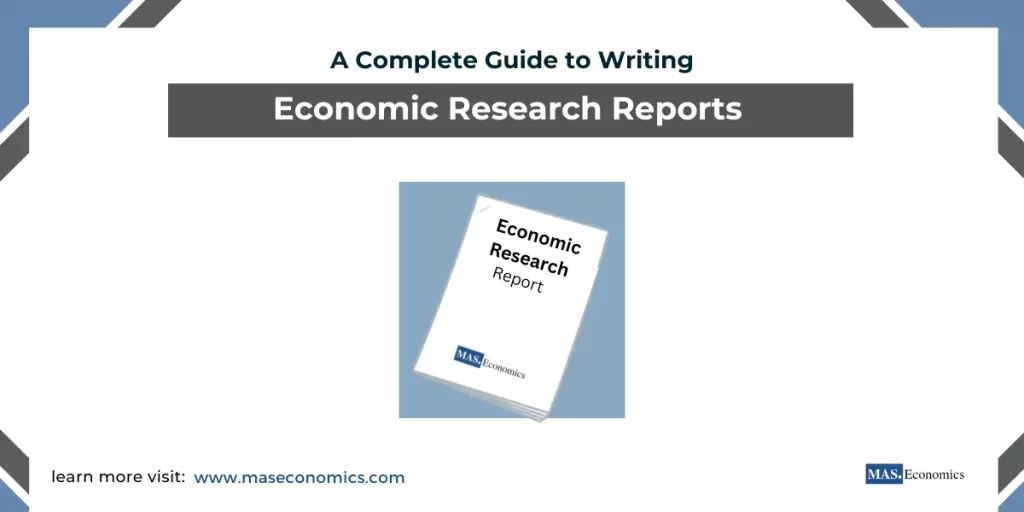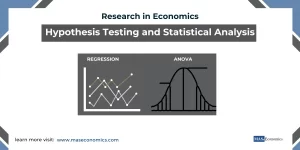In economic research, producing well-structured, clear, and concise research reports is crucial for effectively communicating findings to policymakers, academic peers, businesses, and the public. An economic research report presents the results of an in-depth analysis and highlights the implications of those findings. Crafting a well-organized report ensures that complex data and methodologies are accessible, enabling readers to understand and act on the research insights.
This article provides a comprehensive guide on writing economic research reports, covering the essential sections that should be included, best practices for presenting data visually, and tips for writing clear and effective research findings.
Structuring an Economic Research Report
An economic research report typically follows a standard structure that helps organize the research process and ensures clarity. Below is a recommended structure for writing a comprehensive economic research report:
Abstract
The abstract provides a concise summary of the research, offering readers a snapshot of the key points. It typically includes the research question, methodology, main findings, and conclusions. The abstract should be between 150–250 words and offer enough detail to inform the reader about the report’s significance without delving into too much detail.
Best Practices for Writing the Abstract:
- Keep it concise and clear, summarizing the main points of the research.
- Avoid technical jargon—write for a general audience.
- Include the research question, key findings, and implications of the results.
Introduction
The introduction sets the stage for the research, explaining the background and context of the study. It introduces the research problem, outlines the objectives of the study, and explains why the research is important. The introduction should also include a brief literature review to highlight gaps in existing knowledge and the contribution your study makes to the field.
Key Components of the Introduction:
- Research Problem: Clearly define the economic issue being investigated.
- Objectives: State the objectives of the research, what it aims to achieve, and the questions it seeks to answer.
- Relevance: Explain the significance of the research and its potential policy or business implications.
- Literature Review: Briefly summarize existing studies related to your topic, identifying gaps that your research addresses.
Methodology
The methodology section outlines the research design, data collection methods, and analysis techniques used in the study. It explains how the research was conducted and justifies the chosen methods. In economics, the methodology often includes statistical tools such as regression analysis, econometric models, or surveys. This section should be detailed enough for other researchers to replicate the study.
Best Practices for Writing the Methodology Section:
- Clearly describe the data sources (e.g., government databases, surveys) and the time frame of the data.
- Explain the econometric or statistical models used to analyze the data.
- Justify why the chosen methods are appropriate for answering the research question.
- Provide details on how any biases or limitations were addressed.
Results
The results section presents the key findings of the research. This is where you report the outcomes of your analysis, but without interpretation or speculation—that belongs in the discussion or conclusion section. The results should be presented in a logical order, often with the help of tables, charts, or graphs to clearly illustrate the findings.
Best Practices for Presenting Results:
- Use tables and figures to summarize large amounts of data visually, making it easier for readers to interpret.
- Clearly label charts and tables, providing descriptive titles and captions.
- Organize results based on the research objectives or hypotheses tested.
- Avoid overloading the results section with too much detail—highlight key findings.
Discussion/Analysis
The discussion section interprets the results, explaining their significance and how they relate to the research objectives. It is here that you address whether the findings support or refute your hypotheses and how they fit into the broader literature. You may also discuss any limitations encountered in the study and suggest areas for further research.
Key Elements of the Discussion Section:
- Interpretation: Explain what the results mean in the context of your research question.
- Implications: Discuss the practical or policy implications of the findings, particularly if they challenge existing economic theories or provide new insights.
- Limitations: Acknowledge any limitations in the study, such as data constraints or model assumptions, and explain how they might affect the results.
- Comparison to Existing Literature: Compare your findings with those from other studies, highlighting similarities or differences.
Conclusion
The conclusion summarizes the key findings and emphasizes the significance of the research. This section is a synthesis of the entire report, revisiting the objectives and offering a final assessment of the results. The conclusion should also provide recommendations based on the research, particularly if the study has policy or business implications.
Best Practices for Writing the Conclusion:
- Restate the research objectives and how they were addressed by the findings.
- Provide a concise summary of the main results and their implications.
- Offer recommendations for policymakers, businesses, or further research.
- Avoid introducing new information or analysis in the conclusion.
References
The references section lists all the sources cited in the research report. This includes books, academic articles, data sources, and reports. Ensuring proper citation is essential for academic integrity and allows readers to follow up on the sources used in the research.
Best Practices for References:
- Follow a consistent citation style, such as APA, MLA, or Chicago.
- Include all the relevant information for each source, such as the author’s name, publication year, title, and publisher.
- Double-check that every source cited in the report is included in the reference list.
Best Practices for Presenting Data Visually
In economic research reports, presenting data visually is essential for helping readers interpret complex datasets. Visual representations like charts, graphs, and tables can simplify data and highlight key trends.
Choose the Right Visualization Type
Different types of data require different visualizations. For example:
- Bar Charts: Useful for comparing categories, such as employment rates across industries.
- Line Graphs: Ideal for showing trends over time, such as GDP growth rates over several years.
- Scatter Plots: Effective for illustrating relationships between two variables, such as inflation and unemployment rates.
Keep It Simple
Avoid overloading visualizations with too much data or unnecessary elements. Stick to a clean design, with clear labels and captions that explain the figure’s significance.
Use Consistent Units and Scales
Ensure that units of measurement and scales are consistent across all visualizations. For instance, when comparing GDP figures for different countries, use the same currency units (e.g., US dollars) and adjust for inflation if necessary.
Highlight Key Data Points
Use colors or markers to draw attention to important trends, inflection points, or comparisons that are critical to the research findings.
Tips for Writing Clear and Concise Research Findings
Economic research often involves complex data and technical language, but clear communication is crucial for ensuring that the findings are accessible to a broad audience. Here are some tips for writing effectively:
Avoid Jargon
While technical terms may be necessary in some cases, try to limit jargon and explain key terms when introducing them. Remember that not all readers may have an economics background.
Be Concise
Long, convoluted sentences can confuse readers. Focus on clarity by writing in short, direct sentences. Each paragraph should communicate one main idea.
Use Active Voice
When possible, use active voice rather than passive voice to make the writing more engaging. For example, “The study analyzed the relationship between inflation and unemployment” is clearer than “The relationship between inflation and unemployment was analyzed by the study.”
Focus on Key Findings
While it may be tempting to include every detail of the analysis, it’s important to focus on the key findings that directly address the research question. Extraneous details can distract from the core message.
Conclusion
Writing economic research reports requires careful organization, clear communication, and the effective presentation of data. By following a structured approach—including sections such as the abstract, introduction, methodology, results, and conclusion—economists can ensure that their research is easily understood and impactful. Visual data presentation and concise writing are equally important for conveying complex findings in a way that resonates with both academic and non-academic audiences.
As we conclude this series on research methods in economics, it’s clear that mastering the art of writing and presenting research findings is critical for advancing economic knowledge and influencing policy decisions. Following best practices in report writing not only enhances the quality of the research but also increases its relevance and accessibility to a broader audience.
FAQs:
What is the importance of writing clear research reports in economics?
Clear research reports in economics are essential for effectively communicating complex data, methodologies, and findings to a wide audience, including policymakers, academics, and businesses. Well-written reports ensure that research insights are accessible and actionable, leading to informed decision-making.
What is the typical structure of an economic research report?
An economic research report typically includes the following sections: Abstract, Introduction, Methodology, Results, Discussion/Analysis, Conclusion, and References. Each section plays a crucial role in organizing and presenting the research findings clearly.
How should I write the abstract for an economic research report?
The abstract should be a concise summary of the research, including the research question, methodology, key findings, and conclusions. It should be between 150-250 words and provide readers with a snapshot of the report without technical jargon.
What should be included in the introduction of an economic research report?
The introduction should provide background information on the research problem, define the research objectives, explain the significance of the study, and include a brief literature review to highlight gaps that the research addresses.
How do I present the methodology in an economic research report?
In the methodology section, describe the research design, data sources, and analysis methods used in the study. Ensure that the methods are justified and detailed enough for other researchers to replicate the study. Include econometric models or statistical techniques where relevant.
What is the best way to present results in an economic research report?
The results section should present the findings without interpretation, using tables, charts, or graphs to make the data more accessible. Ensure that the visual elements are clearly labeled and focus on key results that answer the research questions.
How can I effectively interpret research findings in the discussion section?
In the discussion section, interpret the results in the context of the research question. Discuss whether the findings support or refute your hypotheses, explore the implications of the results, address any limitations, and compare your findings with existing literature.
What should the conclusion of an economic research report focus on?
The conclusion should summarize the key findings, restate the research objectives, and highlight the significance of the results. It should also offer recommendations for policymakers, businesses, or further research, based on the findings of the study.
How do I ensure that data is presented visually clearly and effectively?
Choose the appropriate visualization (e.g., bar charts, line graphs, scatter plots) for the type of data. Keep visual elements simple, with clear labels and consistent units. Highlight key data points using colors or markers to draw attention to important trends.
What are some tips for writing clear and concise research findings?
To write clear findings, avoid jargon, be concise, use an active voice, and focus on key results that address the research question. Long sentences and unnecessary details can confuse readers, so aim for short, direct communication.
Thanks for reading! Share this with friends and spread the knowledge if you found it helpful.
Happy learning with MASEconomics




